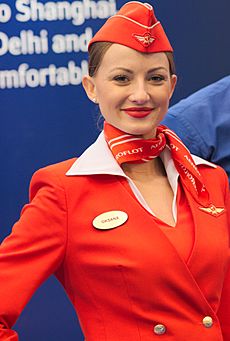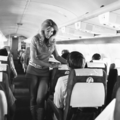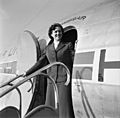Flight attendant facts for kids
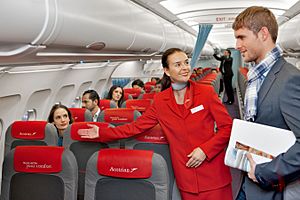
A flight attendant is a special member of the aircrew on planes. You might also hear them called a steward or stewardess, or air host or air hostess. Together, they are known as cabin crew. Their main job is to keep passengers safe and comfortable during the flight. This includes helping people on commercial flights, private business jets, and some government planes.
Contents
What do Flight Attendants do?
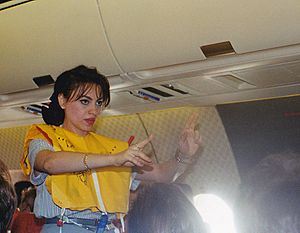
Before a flight, flight attendants and pilots check everything. They look at safety lists and make sure emergency equipment is in place. They also check for passengers who need extra help, like small children traveling alone. They talk about the weather and if the flight might be bumpy.
They do a safety check to ensure things like life vests and flashlights are ready. They also watch for any strange smells or situations in the cabin. They help passengers put their carry-on bags away. They make sure bags are not too heavy or big. They also check for any dangerous goods.
Flight attendants confirm that people sitting in emergency exit rows can help if there's an evacuation. Then, they show everyone how to use safety equipment. This is called a Pre-flight safety demonstration. After that, they "secure the cabin." This means making sure tray tables are put away and seats are upright. They also check that seat belts are fastened before the plane takes off.
Once the plane is flying, flight attendants usually serve drinks and food. They use a special airline service trolley for this. When they are not serving, they regularly check the cabin. They listen for any unusual noises or situations. They also check the bathrooms to make sure smoke detectors are working. They restock supplies there as needed.
They also check on the pilot(s) in the cockpit to make sure they are okay. Flight attendants respond to call lights from passengers needing help. If the flight gets bumpy, they make sure everyone is safe. Before landing, they collect all loose items, trays, and trash. They also put away all service and galley equipment. All hot liquids must be thrown away.
A final cabin check is done before the plane lands. It is very important for flight attendants to be alert. Most emergencies happen during take-off and landing. After landing, flight attendants stand at the exits. They watch the plane and cabin as passengers leave. They also help passengers with special needs and small children get off the plane. They follow rules to make sure children are safely given to the right person.

Flight attendants learn how to handle many kinds of emergencies. They are also trained in first aid. Common situations include nosebleeds, sickness, or small injuries. They also learn to deal with difficult passengers. Emergency training covers things like sudden stops during take-off. It also includes emergency landings and medical issues. They learn about smoke or fires in the cabin. They also learn about pressure changes and emergency evacuations. They are even trained for water landings.
How to Become a Flight Attendant
Training
Flight attendants usually train at the airline's main city or headquarters. This training can last from four weeks to six months. The exact time depends on the country and the airline. The most important part of their training is safety. Attendants are tested on each type of aircraft they will work on.
In the United States, the Federal Aviation Administration (FAA) has rules. Flight attendants on planes with 20 or more seats need a special certificate. This certificate shows they have completed the required training. It is not a pilot's license, but it proves they are trained. This certificate belongs to the attendant, not the airline. It has two ratings, Group 1 and Group 2. These depend on the type of aircraft they trained on, like propeller planes or turbojets.
There are also private training schools not linked to any airline. Students at these schools get similar training. They also learn skills to help them find a job. Some of these schools use real airline equipment for lessons. Others have full simulator cabins that can create emergency situations. In some countries, like France, you need a degree and a safety training certificate.
Language Skills
Flight attendants who speak many languages are often needed. This helps them talk to people from different countries. Besides English, other important languages include French, Russian, Hindi, Spanish, Mandarin, Cantonese, Bengali, Japanese, Arabic, German, Portuguese, Italian, and Turkish. In the United States, airlines often pay extra for language skills. Some airlines even hire people specifically for certain languages. This happens when they start flying to new international places.
Height Requirements
Most airlines have rules about how tall flight attendants must be. This is for safety reasons. It makes sure they can reach emergency equipment above their heads. Usually, the acceptable height is between 150 to 185 centimeters (about 4 feet 11 inches to 6 feet 1 inch). Some airlines, like EVA Air, also have height rules for how attendants look. Smaller planes with low ceilings might also have height limits.
Flight Attendant Uniforms
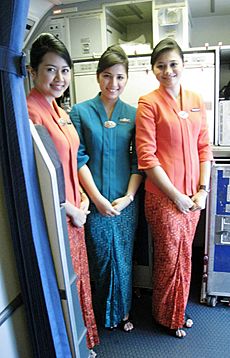
The first flight attendant uniforms were made to be strong and practical. They also aimed to make passengers feel safe. In the 1930s, the first female flight attendants wore uniforms that looked like nurses' outfits. For example, United Airlines' first female flight attendants wore green berets and capes. Other airlines, like Eastern Air Lines, also dressed female flight attendants in nurses' uniforms. Today, male and female flight attendants for Hawaiian Airlines wear aloha shirts as their uniform.
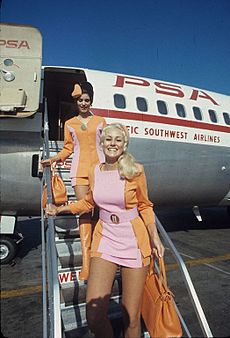
Many early uniforms looked like military outfits. They had hats, jackets, and skirts with straight lines. They also had military details like epaulettes and brass buttons. Many uniforms had different versions for summer and winter. These versions used different colors and fabrics for the season. For example, navy blue for winter and khaki for summer.
As women's roles in aviation grew, airlines saw the value of their female flight attendants. More feminine styles and colors started appearing in the late 1930s and early 1940s. Some airlines hired famous designers to create unique and attractive clothes.
In the 1960s, Pacific Southwest Airlines (PSA) was known for bright uniforms. These included short miniskirts. In the early 1970s, their uniform changed to hotpants.
From the 1980s until now, many Asian airlines use traditional clothing in their uniforms. This is especially true for national airlines. It helps them show off their country's culture and welcome passengers. For example, Thai Airways flight attendants change into traditional Thai costumes before passengers board. Garuda Indonesia flight attendants wear a special kebaya uniform. It is inspired by traditional batik patterns. Malaysian and Singapore Airlines flight attendants also wear batik prints. Vietnam Airlines flight attendants wear red áo dài. Air India flight attendants wear a sari on all passenger flights.
In the mid-1990s, some US airlines required female flight attendants to wear high heels. The minimum heel height varied. Sometimes, flight attendants would change into more comfortable shoes during flights.
In 2015, the Israeli airline El Al asked female flight attendants to wear high heels. This was until passengers were seated. The airline's union said this could harm the attendants' health. The rule was removed later that year.
Until 2016, some female crew members at British Airways had to wear a specific uniform. This uniform did not traditionally include trousers. In 2019, Virgin Atlantic started allowing its female flight attendants to wear trousers. They also no longer had to wear makeup.
Health Considerations for Flight Attendants
Studies have looked into the health of flight attendants. A 2018 study found that flight attendants might have a slightly higher chance of certain health conditions. These include some types of cancer and skin issues. They also found more breathing problems and muscle injuries. Mental health conditions were also reported more often.
The study did not say exactly why these increases happen. However, the authors suggested some reasons. These include more exposure to ionizing radiation from being in the higher atmosphere. Also, poor air quality in the cabin and disrupted sleep cycles could be factors. Flight attendants often have changing work schedules. This can affect their sleep and meal times.
Flight Attendants in Advertising
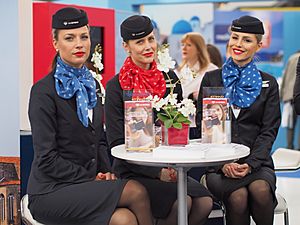
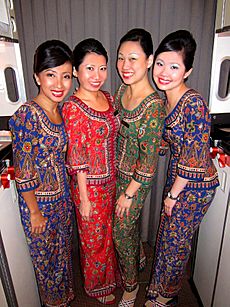
In the 1960s and 1970s, many airlines used flight attendants in their ads. They often showed them as attractive and friendly. National Airlines had a "Fly Me" campaign. It used female flight attendants with slogans like "I'm Lorraine. Fly me to Orlando." Braniff International Airways had a campaign called "Air Strip." It showed female flight attendants changing uniforms during the flight.
In the United States, many airlines used to have rules. Only unmarried women could be flight attendants. They also had a required retirement age, often 32. This was because of old beliefs about how women would look after that age. Many women were hired from colleges or beauty pageants. In 1968, a government agency said these age rules were unfair.
Flight attendant Roz Hanby became well-known. She was the face of British Airways in their "Fly the Flag" ads for seven years in the 1980s. Singapore Airlines still uses the image of their female flight attendants, called Singapore Girls, in their ads. However, they are slowly changing this. They now focus more on showing how modern their planes are.
Gallery
-
Air Dolomiti flight attendant
-
Scandinavian Airlines flight attendants in the 1960s
-
Southwest Airlines flight attendant
See also
 In Spanish: Auxiliar de vuelo para niños
In Spanish: Auxiliar de vuelo para niños


